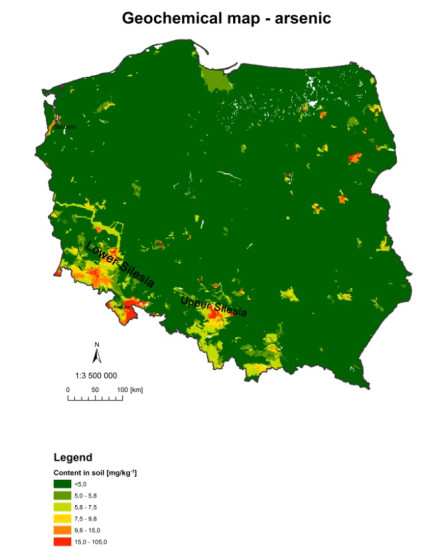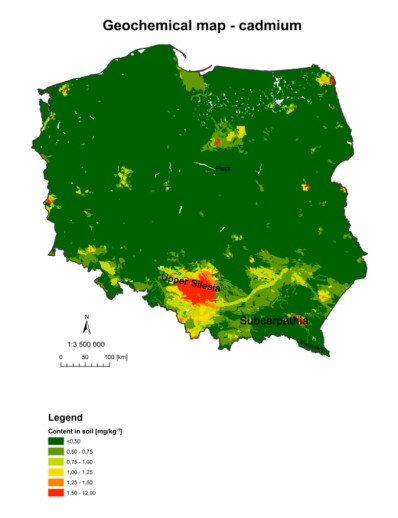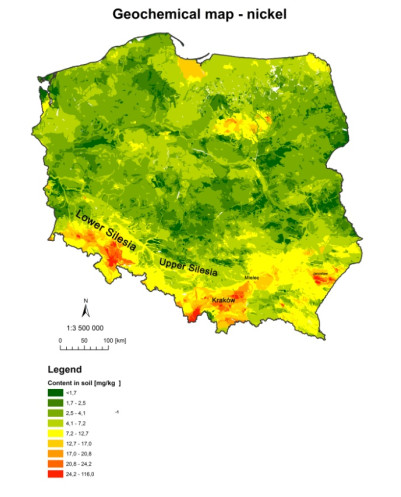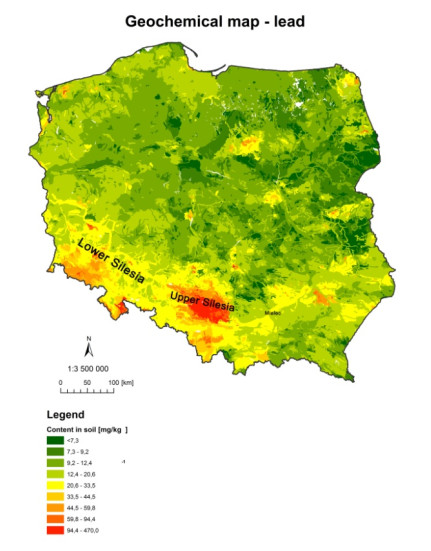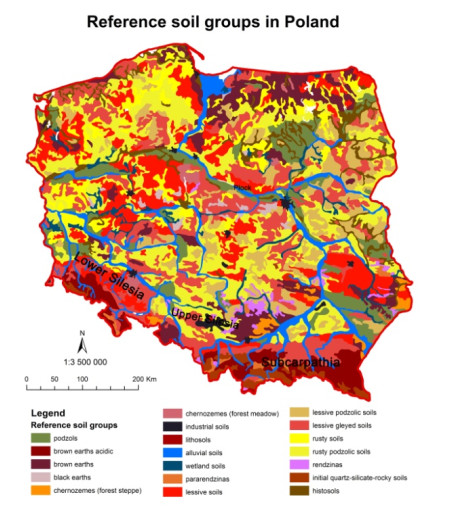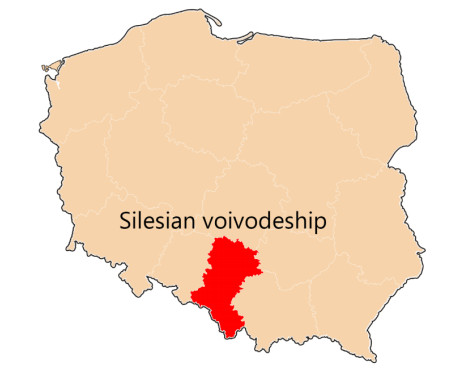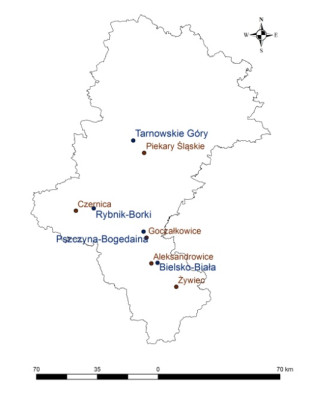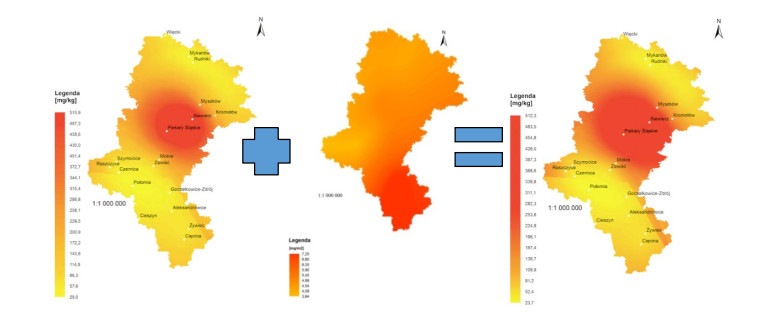The increasing number of spatial data sets permits their application for minimising the duration and cost of such research. An example of such application is geostatistical modelling. Data on the quality of atmospheric air can be used for the assessment of the quality of soil in a given area. The objective of the study was an attempt to apply geostatistical methods in the estimation of the degree of soil contamination with selected heavy metals resulting from deposition from atmospheric air. This paper uses data obtained from the State Environmental Monitoring (data on the quality of atmospheric air) and other collections of publicly available spatial data for the purpose of analysis of the state of quality of soils in the province of Silesia in Poland. Conducted analyses revealing that contamination with lead in atmospheric air in the Silesian voivodeship considerably exceeds acceptable values, and the load of lead deposition is largely transferred to the soil. The paper also presents geochemical maps necessary to understand sources of soil contamination, including their natural content.
1.
Introduction
Volatile organic compounds (VOCs) encompass a diverse group of volatile hydrocarbon chemicals that are present in the atmosphere at ambient temperatures. These compounds contribute significantly to odor pollution, which can have adverse effects on the environment [1]. Livestock production activities, in particular, are known to be a major source of VOC emissions, leading to environmental issues like odor nuisances and land pollution [2]. Moreover, health concerns arise due to prolonged exposure to odor pollution, as it involves the continuous inhalation of numerous chemical components. Chronic or long-term exposure to these VOCs can result in various health problems, making it crucial to address and manage odor pollution effectively [3,4]. The poultry industry is a significant source of odor pollution, and its adverse effects on air quality and human health have received significant attention [3,5]. Intensive poultry production gives rise to various odorous VOCs and gases like ammonia and hydrogen sulfide. Among the gaseous emissions, ammonia (NH3) is of particular concern. Moreover, odor nuisance can be a significant issue for surrounding communities [6,7]. The VOCs emitted from chicken feces and bodily fluids can be odorous [8]. Some odorous substances from these facilities may pose health risks to livestock, workers and the environment [4,5,9,10]. Prolonged exposure to odor causes respiratory and campylobacters infection, the major poultry-borne zoonotic pathogens [11,12]. Environmental pollution can be reduced by formulating poultry diets based on the nutrients available in the ingredients [11,13,14].
Recently white meat that is low in fat and antibiotic-free has become famous among general consumers [5,15,16]. The free-range system in poultry farming involves providing a housing structure and access to pasture or outdoor runs, enabling animals to express their natural behaviors more freely than in closed systems [17]. Consumer interest in organic and free-range poultry production continues to experience steady growth. Furthermore, consumers associate organic production not only with positive health outcomes, animal welfare and environmental considerations but also with good taste [18]. The demand for free-range poultry products is experiencing rapid growth. As free-range eggs and chicken meat become more prevalent in the market, the premium prices associated with these products are expected to decline, putting pressure on upstream costs [19]. Given the current strong demand for native free-range chicken products and their relatively expensive pricing, it is important to gain a thorough understanding of all the fundamentals and details associated with this type of poultry to ensure its viability for commercial and industrial production. However, little is known about the emission and concentrations of VOCs from organic-free-range chicken farming, and the environmental impact of these emissions has been underestimated. Considering the growing consumer interest in free-range poultry products, we aim to comprehensively examine the emission of VOCs from organic-free-range chicken production. We also seek to shed light on the underexplored environmental consequences and the effects of VOCs on human and animal health. Our overarching goal of this review is to provide a broader perspective on the roles of VOCs in animal production, offering valuable insights for sustainable and responsible poultry farming practices.
2.
Types of volatile organic compounds and odorants in chicken farming
The environmental problems caused by volatile organic compounds in nervous systems are due to their offensive odor and toxicity. For humans, extended exposure to VOCs can cause inflammation of the eyes and throat, liver damage and damage to the central nervous system. VOCs may also have carcinogenic properties. VOCs can also contribute to ozone depletion, tropospheric ozone production and global warming. As a result, VOCs are subject to stricter regulations; in Europe, for instance, the European Union Directive 1999/13/EC on the limitation of VOC emissions [20].
During poultry production, farm biomass, chicken manure and anaerobic microbial decomposition are the primary sources of malodor, foul odor or unpleasant smell on the farm [21,22]. Odor has long been associated with animal production, and data for 1997–2013 reveal that poultry generates the highest levels of odor [11]. Factors such as animal diet, spill feed, urine, fresh manure and anaerobic microbial decomposition contribute to the generation of odor on poultry farm [21]. Generally, feed and body odors are not considered offensive as manure and its decomposition during collection are. Manure decomposes anaerobically under a range of moisture and temperature conditions, resulting in the production of odorous volatile compounds [23]. Some compounds result from microbial degradation, with carbohydrates and proteins as the substrates for their formation [24]. The type and quantity of VOCs produced can vary depending on several factors, including the type of poultry litter, the composting method and the environmental conditions such as temperature, humidity, wind speed and direction, season and distance during composting [20]. Other variables include the type of chicken, housing system, building structure, ventilation system, bedding materials, flow rate, feed type and quantity, animal activity level, manure handling system, building management (cleaning and disinfection procedures) and cleaning practices [22].
2.1. Methane
Methane (CH4) is produced by the microbial decomposition of soluble lipids, carbohydrates, organic acids, proteins and other organic compounds. CH4 is an additional potent greenhouse gas (GHG). The presence of atmospheric CH4 has been linked to climate alterations [3]. Since the beginning of the industrial period, CH4 concentrations have increased two-fold with a global mixing ratio of approximately 1,890 parts per billion (ppb), making a significant increase since pre-industrial time. Due to its effects on atmospheric chemistry and climate, the rapid increase in atmospheric CH4 concentrations is a cause for concern. CH4 is the troposphere's third most prevalent GHG (after water vapour and carbon dioxide, or CO2). More CH4 is a considerably more potent GHG than more CO2, both on a molecule and mass basis [25,26,27]. Its increasing concentrations in the atmosphere contribute to global warming and climate change. In addition to its impact on global warming, CH4 plays a significant role in atmospheric chemistry. It reacts with other gases in the atmosphere, including ozone and water vapour, to produce a range of other compounds, such as formaldehyde (CH2O), nitrogen oxides and organic compounds. The first is a toxic and reactive gas that can contribute to ground-level ozone and particulate matter formation. The others have complex and far-reaching effects on atmospheric chemistry and air quality. According to carbon emissions, there are significant environmental effects. Additionally, the creation of CH4 is considerably aided by the animal production sector, particularly through the use of chicken manure [28,29]. Large amounts of poultry manure have been produced as a result of the concentration of chicken farms on relatively small land areas. On average, a single chicken produces around 80 to 100 grams of manure per day, which, when considering the scale of the industry, leads to a significant environmental impact. For instance, Malaysia alone generated approximately 77,209 tons of chicken manure daily in 2014. This immense volume of waste holds the potential to generate up to 3.86 million cubic meters of CH4 through anaerobic digestion [30]. The release of CH4, a potent GHG, further exacerbates the environmental challenges posed by the animal production industry [31]. Gac et al. [32] reported that the emissions from litter manure in the chicken house were found that the amount of CH4 emission for egg hens, pullets and litter manure during storage were 0.053 and 0.013 kg of CH4/head/year. Understanding the makeup of the anaerobic microbiome and the way microorganisms interact with each other is extremely important. This is because an anaerobic reactor's proper functioning and stability depend on the microbial community's specific arrangement and dynamics [33].
Figure 1 illustrates the correlation between the breakdown of chicken manure and the microbiome in the digesters. It encompasses the key types of bacteria engaged in the process, their respective fermentation activities and the resultant products generated. Converting chicken manure into CH4 relies on the collaborative efforts of various microorganisms, which can be categorized into two main groups. Carbohydrates in the manure can be degraded to polysaccharides and monosaccharides before being converted to VFA by bacteria (Clostridium IV), acetate and CH4 by the contribution of Methanothris and Methanosarcina. Proteins and lipids undergo a series of microbial transformations before CH4 is released by archaea, specifically Methanobacterium and Methanosarcina. Initially, proteins are hydrolysed into peptone, which is further broken down into amino acids. Bacteria, like Gallicola, convert these amino acids into butyrate. Furthermore, lipids are transformed into glycerol and fatty acids, which are subsequently digested by Syntrophomonas. Throughout the process, urea is converted into NH3. Eventually, these metabolic pathways culminate in the production of lactate and the subsequent release of CH4 by archaea. Additionally, the influence of bioaugmentation on the archaeal community was found to be more pronounced than its impact on the bacterial community [34].
2.2. Non-methane volatile organic compounds
In broiler sheds where birds are raised for human consumption, odorants are either released by the birds or produced in the litter. Non-methane volatile organic compounds (NMVOCs) are a type of air pollutant comprising organic compounds that can quickly vaporize and become airborne, resulting in various environmental and health effects. In poultry farming, NMVOCs primarily originate from the waste products generated by the birds, including their manure and bedding materials. The chemicals and odorants frequently identified as NMVOC are listed in Table 1. Microbial activity, including Bacillus, Atopstipes, Clostridium and Lactobacillus, initiates the decomposition process by converting complex organic compounds into simpler ones, resulting in the production of various compounds over time [35]. The compositions and combination of NMVOCs vary depending on various factors such as their age, activity level and diet [36,37]. In addition, NMVOCs can be detected during various stages of chicken production. However, the specific VOCs and their concentrations may vary depending on the production practices, management and environmental factors. NMVOCs may arise from different sources, including manure management, feed storage and cleaning practices. As organic materials decompose, these compounds can be released into the air, contributing to indoor air quality challenges within chicken production facilities. Among the examples of NMVOCs, certain compounds like benzene, toluene, ethylbenzene and xylene are commonly found in gasoline, paint thinners and industrial solvents, respectively. Additionally, formaldehyde, acetone, butadiene and ethylene are present in various industrial processes and products, with some compounds, such as benzene, recognized as known carcinogens. As organic materials decompose, these compounds can be released into the air, contributing to indoor air quality challenges within chicken production facilities. Effective ventilation and management strategies are vital to mitigate the accumulation of NMVOCs and maintain a healthy environment for chickens and workers. Terpenes, although not directly formed in poultry waste, can be indirectly present if poultry consumes feed containing aromatic herbs or plants, resulting in their transfer to the waste [38,39]. Aromatics, such as benzene, toluene and xylene, are released during the decomposition of organic matter, including lignin, while further degradation of organic compounds, such as carbohydrates and lipids, results in the production of alcohols (e.g., methanol, ethanol) and ketones (e.g., acetone, methyl ethyl ketone) [40,41]. Aldehydes, such as formaldehyde and acetaldehyde, are produced as byproducts of microbial degradation of organic compounds in poultry waste, contributing to the overall VOC emissions associated with poultry farming and emitting distinct odors [42,43]. Carboxylic acids, including acetic acid, propionic acid and other fatty acids, are also released through microbial degradation of organic matter in poultry biomass [43,44]. These compounds are part of the overall VOC emissions and can contribute to the odorous characteristics of poultry farming [42].
2.3. Non-volatile organic compounds
Ammonia, when present in high concentrations, can lead to acidification of soil and water, causing harm to plants and aquatic organisms [45]. Inhalation of NH3 can irritate the respiratory system, particularly in individuals with pre-existing respiratory conditions [46]. The decomposition process generates NH3 as a byproduct from the breakdown of nitrogen-containing compounds, such as proteins [47]. The estimated global chicken NH3 emissions are around 5.5 Tg(N) yr−1 (Teragrams of Nitrogen per year), which accounts for approximately 13% of total agricultural NH3 emissions [48]. The production of NH3 as a by-product of poultry production is a significant concern, as various factors influence NH3 production in poultry houses. When concentrations of NH3 exceed permissible limits, typically 15–20 ppm, it can lead to disastrous consequences, including negative health and welfare effects on poultry, their caretakers and the overall production efficiency [49,50]. NH3 exposure increases infection risks, alters bird behavior and reduces production efficiency, affecting feed intake, growth, egg production and overall costs [51]. Volatile fatty acids (VFAs) emitted from poultry farms contribute to unpleasant odors in the vicinity, affecting the quality of life for nearby residents and potentially leading to respiratory irritation, including symptoms such as coughing and throat irritation, upon prolonged exposure to high levels [52,53]. Such compounds, including acetic acid, propionic acid and butyric acid, are formed as microbes metabolize carbohydrates and lipids in the waste [54,55]. Sulphide species are often associated with emissions from agricultural and livestock activities, such as broiler sheds and industrial processes [56]. Sulfur-containing compounds in the waste, such as proteins and amino acids, decompose and release sulfide species compounds like hydrogen sulfide (H2S) and other volatile sulfur compounds [57]. Phenols and indoles are additional compounds that can be emitted from poultry farming, particularly from the decomposition of poultry waste, with phenols being produced as organic matter, including lignin, breaks down, contributing to the overall odor emissions [58,59]. While they are not classified as NMVOCs, they are worth mentioning as they contribute to the overall emissions and can have environmental and health implications [8,60]. Phenol and indole are indicators of the quality of litter or bedding material in poultry houses; odorous compounds with long-term exposure can cause irritation of mucosal membranes in the respiratory tract of farm chickens [61].
3.
Free-range chicken farming
Free-range chickens are a farming system that offers outdoor access, allowing the birds to roam freely, forage for natural food sources like insects, plants and seeds, and express their innate behaviors. This method stands in contrast to conventional factory farming, providing a more humane and sustainable approach to poultry production. By allowing the chickens to lead healthier and happier lives, they are more likely to produce better-quality eggs and meat. While the provision of outdoor access poses challenges, proper management and monitoring ensure the safety and well-being of the birds [62,63]. In a free-range chicken farming system, the birds are encouraged to find food by foraging outdoors. However, supplementary feed is also provided to meet their nutritional requirements, especially during certain seasons or when natural forage is limited. The feed for free-range chickens typically includes a mix of grains, such as corn, wheat and barley, along with protein sources like soybean meal, ensuring they receive the necessary carbohydrates, proteins and fats for healthy growth and egg production [64,65]. In Europe, free-range poultry production has a long-established history, exemplified by the well-known "Label Rouge" certification for chickens in France. This certification signifies a commitment to high animal welfare standards and product quality. It encompasses practices such as providing extensive outdoor access for birds, using slower-growing breeds, prioritizing humane living conditions and setting a benchmark for poultry farming methods across Europe and beyond [66,67]. Likewise, in the United States, pasture-raised poultry is raised in open fields with access to fresh air and natural forage. This practice provides poultry with fresh pasture and small quantities of grass, insects and worms [68], which in turn can lead to enhanced quality of meat and eggs. However, it's essential to note that the percentage of diet substituted by these pasture-derived sources may vary based on factors like breed and age of the bird, environment and forage quality, making it challenging to predict the exact nutrient contribution [69]. When formulating diets for pasture-raised birds, it is advisable to assume minimal nutrient intake from the pasture to ensure their nutritional needs are met.
3.1. Raising the free-rang chicken
Commercial poultry houses confine birds in stressful conditions and often rely on antibiotics in their feed to manage health issues. In contrast, free-range poultry enterprises offer a stress-free environment with ample space, natural diets and exposure to fresh air and sunlight. The antibiotic-free system, along with on-farm hand-processing to ensure a clean and faecal matter-free carcass, enhances food safety and quality compared to commercial poultry products [65,70]. A fundamental principle in free-range chicken production is avoiding the use of growth hormones and routine antibiotics and prioritizing an ethical and responsible approach to animal welfare. If a chicken falls ill and requires medical attention, it is promptly isolated and given appropriate care without compromizing the "free-range" status of the rest of the flock. This dedicated commitment to animal well-being and responsible healthcare practices contributes to the production of healthier, more ethically raised and sustainably raised free-range chickens [71,72,73]. By choosing free-range chicken products, consumers support a more ethical and natural food production system, aligning with their values of sustainable and responsible farming practices. The health benefits of such chicken products are also evident, as they provide better nutritional value due to the birds' natural foraging behaviors and the avoidance of routine antibiotics.
3.2. Spaces and welfare
The primary characteristic of free-range chicken production is that the birds have access to outdoor areas. These areas should be spacious and allow the chickens to roam freely, forage for food and engage in natural behaviors like dustbathing and scratching the ground. In free-range chicken production, hens must have continuous daytime access to open-air runs with predominantly vegetated ground, encouraging natural behaviors like foraging. The maximum stocking density should not exceed 1,000 birds per hectare to avoid overcrowding and allow sufficient space for movement. Additionally, the interior of the chicken housing must conform to specific standards to ensure shelter from extreme weather and appropriate health monitoring. Following these guidelines promotes a more natural, humane and sustainable approach to raising free-range chickens, prioritising their welfare and producing healthier, ethically raised poultry products [68]. In the UK, there are several free-range systems for meat chickens, each designed to keep in mind the welfare and ethical treatment of the birds. The "Free-Range" system permits a maximum indoor stocking density of 13 birds per m2 with access to open-air runs. In contrast, "Traditional Free Range" offers a maximum density of 12 birds per m2 and requires continuous daytime access to open-air runs, providing at least 2 m2 per chicken. For even more freedom, "Free Range - Total Freedom" includes unlimited area open-air runs. The "Organic" system combines free-range conditions with slower-growing chickens, offering organic feed and no routine antibiotics while keeping chickens in smaller flocks with ample indoor and outdoor space. These systems address consumer preferences for more humane and sustainable meat chicken production [74]. In terms of free-range laying egg chickens to promote the welfare and natural behaviors of laying egg chickens, it is recommended to provide ample outdoor space and encourage early exposure to the outdoor area. Ensuring sufficient indoor and outdoor space and offering environmental enrichment can contribute to improved welfare indicators, such as reduced plumage damage and footpad dermatitis incidence in hens [75]. In free-range and organic chicken farming, animal welfare is paramount, as both systems prioritize outdoor access and natural environments for the birds, enabling them to roam freely and forage naturally [76]. Additionally, minimizing stress, refraining from antibiotics and hormones and offering ample space for movement contribute to the chickens' well-being. These practices foster an ethical and sustainable approach to poultry production, providing consumers with healthier and responsibly sourced chicken products. Moreover, sustainability is further emphasized through responsible waste management and the preservation of natural habitats [77]. In conclusion, as illustrated in Figure 2, free-range chicken farming provides a humane and sustainable alternative to conventional methods. The outdoor access and encouragement of natural behaviors lead to healthier, happier chickens, producing better quality eggs and meat. Avoiding routine antibiotics and growth hormones enhances ethical animal welfare. Choosing free-range products supports a natural, environmentally conscious approach to food production, emphasizing animal welfare, sustainability and high-quality, responsibly sourced poultry. Overall, free-range chicken farming represents a positive shift in the poultry industry, emphasizing animal welfare, environmental sustainability and producing high-quality, responsibly sourced poultry products [19,65].
3.3. Regulations
Regulations for free-range chicken farming vary depending on the country and region. However, common standards include providing outdoor access with adequate space for foraging and natural behaviors, minimum indoor space per chicken to prevent overcrowding and access to a natural diet supplemented with feed [78]. In the USA, free-range chicken farming is categorized into three major systems: Pastured, day range and traditional free-range. In pastured and day-range systems, chickens have access to highly nutritious vegetation, and the constant rotation of broiler houses reduces the risk of parasitic infections. Conversely, traditional free-range systems have immobile houses and less abundant vegetation, leading to a higher incidence of parasitic infections. The regulations do not specify stocking density, genotype, feed composition or age at slaughter, but producers must demonstrate that the birds have been given outdoor access. This classification highlights the importance of outdoor access and vegetation in providing a more natural and healthier environment for free-range chickens while allowing producers flexibility in their farming practices [79]. Continuous improvement is essential as producers regularly enhance practices for optimal animal welfare. They prioritize enriching environments and access to natural resources while emphasizing environmental sustainability through eco-friendly practices and resource conservation. Nutritional aspects are carefully assessed for a balanced, natural diet and health monitoring ensures prompt veterinary care to prevent disease outbreaks. Producers adapt to consumer preferences, embrace innovation and seek certifications, resulting in improved welfare, reduced environmental impact and consumer satisfaction [80,81].
4.
Release of volatile organic compounds during free-range chicken production
Producing free-range chicken entails creating a natural and open environment where chickens can roam and forage freely, leading to improved health and well-being. Achieving successful free-range chicken production requires skilfully balancing the birds' welfare needs with the demands of a sustainable and economically viable operation. During free-range chicken production, some of the steps involved can contribute to concerns about VOCs and their impact on the environment. The following are some steps in free-range chicken production that may involve VOCs.
4.1. Foraging and pastures
When free-range chickens are allowed to forage outdoors, they interact with vegetation and soil. In some cases, natural processes, such as the decomposition of organic matter in the soil, can lead to the emission of VOCs. Plants release VOCs as part of their normal metabolic processes [82]. These VOCs can be emitted from plants' leaves, stems and roots [83]. Common pasture plants used in free-range farming include grasses, legumes and native or naturalized species. Examples of grasses commonly used are ryegrass (Lolium perenne), timothy grass (Phleum pratense), Kentucky bluegrass (Poa pratensis) and brome grass (Bromus inermis). These grasses are rich in well-known nutrients and contain unidentified factors that contribute to their nutritional values [84,85,86]. When plants are mechanically stressed, such as during mowing or grazing, they can release VOCs. This is considered the defence mechanism that helps plants protect themselves from predators. The specific types of VOCs emitted from pasture production will vary depending on the type of plants and the management practices used. VOC emissions from undisturbed pastures rose significantly with higher temperatures and intense sunlight, reaching their peak at midday and stopping at night [87]. When the pasture was physically damaged or cut, temporary raises of emissions occurred, which, when measured over time, could be comparable to emissions from undisturbed pastures [88,89]. Terpenes such as α-pinene, β-pinene, limonene, myrcene, linalool, caryophyllene, geraniol and terpinene are common volatiles produced from pastures [90,91,92]. When plants die, they undergo decomposition carried out by a diverse group of soil microbes, including bacteria (e.g., Bacillus sp., Pseudomonas sp.), fungi (e.g., Aspergillus sp., Penicillium sp.), actinomycetes (e.g., Streptomyces sp.), protozoa and earthworms. These microorganisms, consisting of bacteria, fungi, algae, protozoa and nematodes, work together to break down plant material into smaller molecules, making it easier for plants and other organisms to absorb and utilize the nutrients [93]. This process can release VOCs, such as CH4 and H2S [94,95,96]. Reduced sulfur compounds such as dimethyl sulfide (DMS) are known to be produced during the decomposition of organic matter, including plants [97,98,99]. In pastures, when plants go through natural processes of senescence and decay, DMS may be emitted, contributing to the characteristic sweet, sulfurous odor often associated with decaying plant materials [97]. This scent can be noticeable in areas with abundant plant biomass, such as grazed pastures, especially during active plant growth and decomposition periods. Ethylene is the VOCs produced during plant growth and microbial activity in aerobic and anaerobic soils [100,101].
4.2. Production of feed
Poultry feed formulations often include grains, legumes and oilseed meals. These ingredients can contain organic compounds that have the potential to release VOCs. The composition of feed or the quality of forage processing, the proportion of forage in the diet and the source of the grain of forage influences CH4 production [102,103]. The study found that free-range eggs have a relatively low carbon footprint compared to white or red meat, with 63% of emissions attributed to embodied carbon in poultry feed. However, the production of eggs heavily relies on cereals and soy, which leads to high emissions from industrial nitrogen production, land-use change and transport. To reduce GHG emissions and dependence on imported raw materials, alternative digestible protein sources for poultry diets, such as those produced from waste processing, are suggested [104]. In organic feed, the absence of synthetic preservatives leads to generally higher microbial activity compared to conventional feed [105]. Bacteria and fungi naturally present in organic feed can produce VOCs as metabolic byproducts during the decomposition and breakdown of organic matter. These microbial VOC emissions may contribute to the overall VOC production associated with organic feed [106,107]. During the processing of free-range chicken feed, mechanical processes such as abrasion and friction can contribute to the emission of VOCs from the feed ingredients [108]. Heat treatments like drying and pelletising can also lead to chemical reactions between organic compounds in the feed, resulting in the formation of VOCs as byproducts. One example is the Maillard reactions, involving the reaction of amino acids with reducing sugars, which can produce VOCs such as aldehydes, ketones and furans during feed processing [109,110]. Additionally, poultry feed contains fish meal as an ingredient that may release dimethyl sulfide, which gives a smell that is characteristic with fish meal-based feeds [111].
4.3. Housing and waste management
Housing for free-range chickens serves as a shelter and protective space, but it can also be a potential source of VOCs. Bedding materials like straw, wood shavings or sawdust in chicken housing can undergo decomposition, particularly when exposed to microbial activity and moisture. This decomposition process can result in the production of VOCs as natural byproducts. It was observed that the majority of the bedding material (rice husk) was absorbent, and additional litter was added daily to prevent wet litter and litter caking, which are associated with NH3 production [112]. Addressing VOC emissions in poultry housing, Yao et al. [113] demonstrated the effectiveness of vegetative environmental buffers in mitigating emissions and addressing environmental concerns. Additionally, in free-range systems, the outdoor activities and scratching behavior of chickens can generate dust, which may contain particulate matter and VOCs. Under dry and windy conditions, this dust, when released into the air, can contribute to air pollution, as highlighted by McGahan [114]. To minimize VOC emissions and control particulate matter in the housing environment, measures such as proper ventilation, regular maintenance of bedding materials and dust management should be implemented. These strategies promote better air quality for both the chickens and the surrounding areas, as suggested by Casey et al. [3], Edwards and Hemsworth [115].
Manure management is a crucial aspect of free-range systems to prevent environmental contamination. However, manure can emit VOCs as it undergoes decomposition, leading to odor issues and potential air pollution if not managed properly. Appropriate waste management practices are key to minimizing VOC emissions and addressing odor concerns [116,117]. Litter used in free-range systems can also contribute to odor emissions. Proper management of litter is essential to mitigate VOC production. Removing soiled litter and adding fresh litter helps maintain a healthier environment with lower odor levels. Regular removal of accumulated manure reduces the opportunity for prolonged decomposition and VOC release. Drying manure can be achieved through adequate ventilation or drying systems, reducing the potential for VOC emissions [3,118]. Figure 3 showed the VOCs released from free-range chicken production system.
5.
Conclusions
The growing demand for free-range poultry products has driven significant expansion in their availability in the market. While this expansion has led to more affordable prices for consumers, it has also placed pressure on the upstream costs associated with free-range chicken production. To ensure the continued success of this industry, a thorough understanding of all aspects of free-range chicken production is essential. VOCs play a significant role in air quality and atmospheric chemistry and their environmental impact has been underestimated. Therefore, it is imperative to study the role of VOC emissions thoroughly, their adverse effects on human and animal health and their environmental challenges. Free-range chicken production involves several steps that can contribute to VOC emissions. Chickens foraging outdoors can interact with vegetation and soil, leading to VOC release through natural processes like organic matter decomposition. Additionally, poultry feed formulations and housing materials can also produce VOCs. Understanding VOC emissions is crucial for addressing environmental and health concerns. By adopting a broader perspective of animal productions and recognising the significance of VOC emissions, the poultry industry can evolve responsibly, ensuring the well-being of consumers and the planet. With careful management and ongoing research, free-range chicken farming can thrive, offering high-quality products while minimizing its ecological impact.
Use of AI tools declaration
The authors declare that they have not used Artificial Intelligence (AI) tools in the creation of this article.
Acknowledgments
We would like to acknowledge the Teaching Assistant and Research Assistant (TA/RA) scholarship from the Graduate School, Chiang Mai University. This research work is partially supported by Chiang Mai University. SKP thanks JSS AHER for the infrastructural support provided. The research project is funded by Targeted Research 2023 (R66IN00339).
Conflict of interest
The authors declare no conflicts of interest.
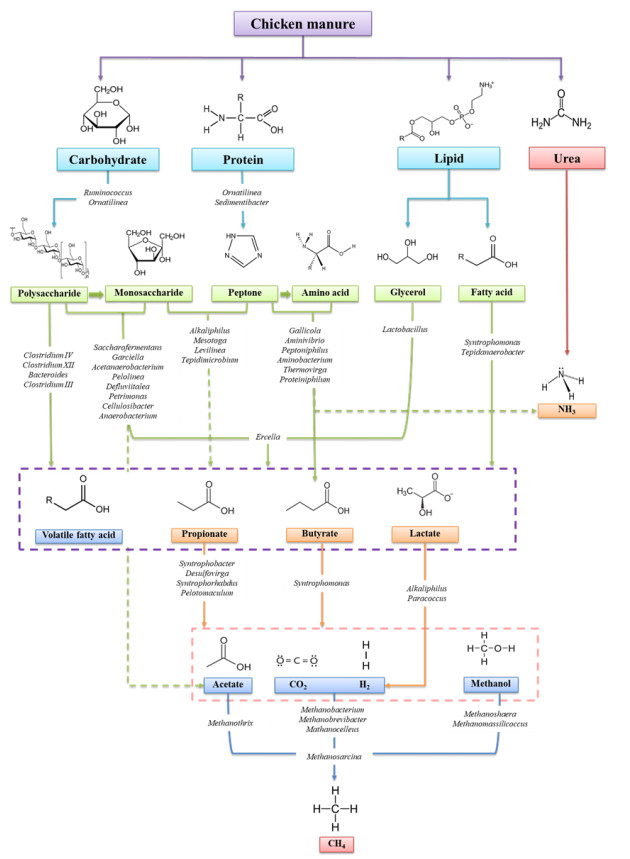









 DownLoad:
DownLoad:




